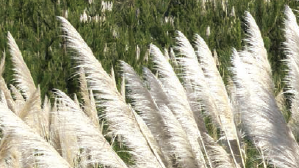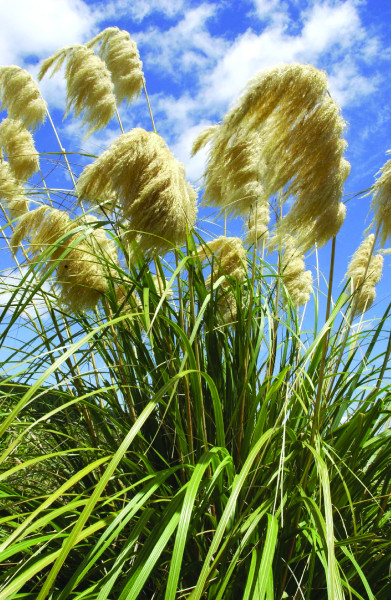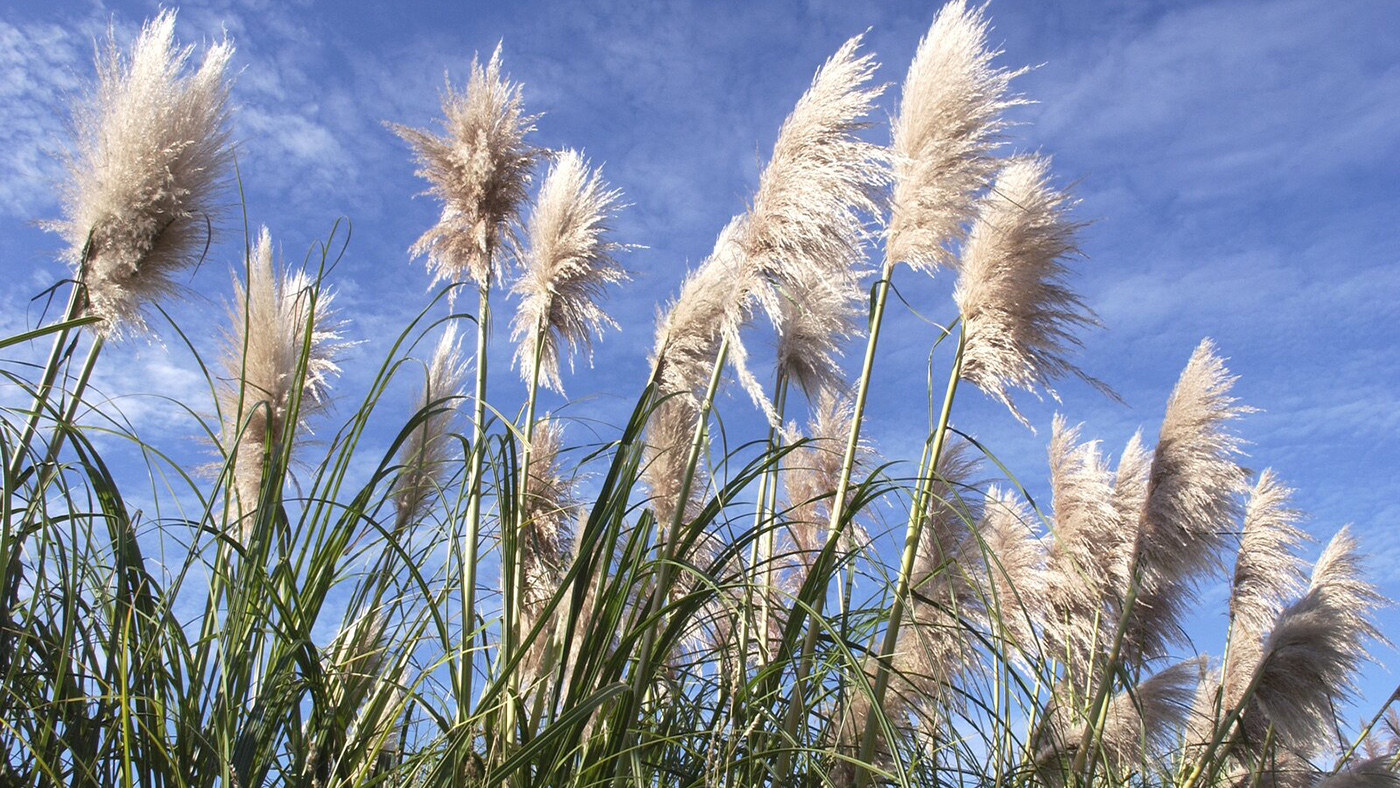| Management programme |
| Sustained control
Site-led (Wetlands) |
| Objectives |
| Sustainably control pampas within quarries to reduce its establishment in and spread from them and keep it from affecting wetlands that are free of or being cleared of it. |
| Impacts |
| Economic, biodiversity |
Common and purple pampas, both originally from South America, are large invasive grasses. They are a serious threat to natural areas like sand dunes, coastal cliffs, and stream banks and wetlands where their dense clumps can completely replace native vegetation.

What does it look like?
Purple pampas (pest plant)
Flower
- Erect, fluffy flowering stems mostly purple, fading to dull brown.
- Flowers from January to March.
Fruit/seeds
- Produces large fluffy seed heads (inflorescence) with numerous seeds.
Leaves
- Leaf bases are not waxy.
- Dark green leaves, stout hollow stems.
- Easily torn leaves and stems – eaten by livestock.
Common pampas (pest plant)
Flower
- Erect, fluffy flowering stems are white, to pinkish fading to off-white.
- Flowers from February to June.
Fruit/seeds
- Produces large fluffy seed heads (inflorescence) with numerous seeds.
Leaves
- Upper side of leaves bluish-green.
- Leaves have serrated cutting edges.
- Leaf bases are not waxy.
- Easily torn leaves and stems – eaten by livestock.
Similar species
Pampas can be confused with native toetoe species (Astroderia spp.). However, there are key differences between them. 
Austroderia fulvida, A. toetoe
Flower head
- Drooping flower heads (to 4 m tall) are creamy-yellow.
- Flowers October to January.
Fruit/seed
- Produces large fluffy seed heads (inflorescence) with numerous seeds.
Leaves/stems
- Tougher leaves and stems than pampas – livestock unlikely to eat it.
- White, waxy covering on leaf bases.
- Veins visible between the midrib and margin of leaves.
- Dead leaves droop but do not form wood shaving-like curls at the base of the clump.
Why is it a pest?
Common and purple pampas are erect, tall, tussock-forming perennial grasses with razor-sharp leaf margins (hence the term ‘cutty grass’). They are a particular problem on roadsides (reducing visibility), along railways, in quarries and in newly planted forests. Infestations of both common and purple pampas are found throughout the Waikato region.
Both introduced pampas species (and their cultivars) are very invasive, and able to form dense impenetrable stands over 3 metres high. Their seed can be easily spread through wind-dispersal, and human-assisted dispersal, for example when it contaminates quarried materials. The ability of their numerous seeds to blanket areas with very rapid exclusive growth makes these plants a particular problem on any disturbed land, wetlands, coastal dune and cliff areas. Pampas inhibits the regeneration of native plant species and can outcompete young pines in plantation forests.
Pampas can also be a fire risk due to the large amount of dry matter it produces, and harbour pests such as rats, mice, rabbit, and possums.
Control methods
Physical control
- Pampas can inflict nasty cuts, so wear gloves and protective clothing.
- For young plants, the best option is to loosen the soil and pull them out.
- For small infestations, cut the trunk or stems off as close to the ground as possible.
- A digger or bulldozer can be used to remove big plants.
- Physical control should be done before seeds form.
- Leaf matter can be left on site, acting as mulch and shading out the seed bank.
Herbicide control
Herbicides are most effective on pampas during spring and early summer while it is growing strongly. Spraying while the plants are flowering is less effective.
Cut stump treatment
- Plants can be slashed to about 30cm from the ground and the regrowth sprayed.
- Large mature clumps may require follow up control.
Spray application
- Very dense sites can be sprayed. Total coverage of the plant is required.
Safety when using herbicides
- Follow the instructions on the manufacturer’s label.
- Always wear protective clothing.
- Always minimise the risk to your other plants.
- Contact the supplier for further advice.
Summary of herbicides and application methods for control
| Herbicide | Application |
| Glyphosate and penetrant | Spray |
| Haloxyfop and crop oil | Spray |
| Herbicide rules will apply. You may need to notify neighbours if spraying. The Waikato Regional Plan explains the agrichemical (herbicides) use rule in section 6.2 | |
| If applying herbicide over water, a resource consent may be required. Please check with Waikato Regional Council before you begin. | |
Management
After initial control, it’s important to:
- clean out the site again at least annually to control regrowth
- stop weeds invading by replanting with non-pest plants (preferably native plants) once regrowth is no longer a problem
More information
Advice
- For advice and additional information on control methods for pampas, call our pest plant staff on freephone 0800 800 401.
- Chemical company representatives, farm supply stores, garden centres or the Weedbusters website can also be good sources for advice.
Publications
The following publications are available for download or from Waikato Regional Council. Contact us to request a copy (freephone 0800 800 401).






To ask for help or report a problem, contact us
Tell us how we can improve the information on this page. (optional)